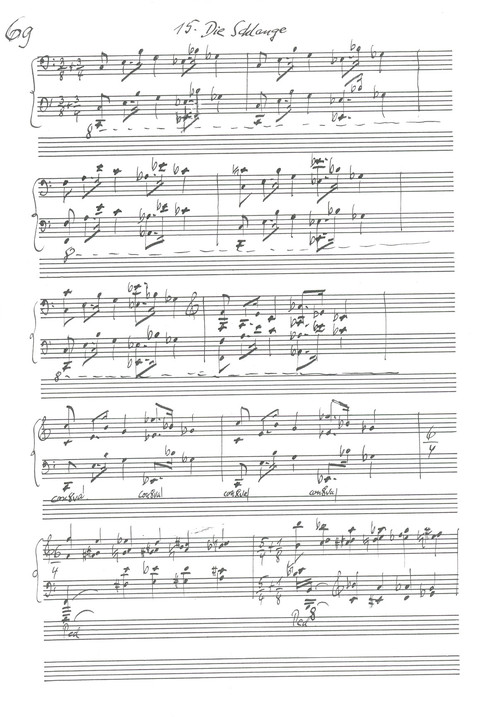Familiarizing with H.E. Erwin Walther’s piano works evolves into a fascinating experience.
This restless man created a big number of lively compositions, trying to characterize those immediately leads one into difficulties with terms and definitions. Is there an underlying system regarding the regime of tones in the sense of twelve-tone music or even a serial arrangement? Should one talk about ‘atonal’ music, are ‘tonal’ elements traceable?
Perhaps one could describe Walther’s music as ‘fee-tonal’; but also, this characterization is inaccurate. It is obvious that the composer preferred no fixed principle regarding the order of the tone – no ‘system’.
The themes, sound combinations, bases of cords, continuation of cords, and rhythms are developing spontaneously within the single composition. It seems that intuition has been the basic principle of his mode of operation. However, with this ‘free-tonal’-way of composing, ‘basic tones’ or ‘central tones’ form the ‘underlying tones’ of the sound, either shorter or longer lasting. Though one can found no longer any arrangement of tonality this music is not ‘atonal’.
Erwin Walther works with themes. While developing the themes its form evolves, leading to sometimes surprises. Although the composer thought, composed and sensed on a conventional basis but puzzled his audience with various unconventional ideas.
Generally speaking, one can hear from Walther’s language of sounds his joy with the expressiveness of dissonance. In the deep areas of his principles, he blends them into gentle colours – without any harshness. Many of his piano compositions embrace a wide variety of cords and impulsive actions – this offers a great poetry!
Text following: Helmut Biehler: Das Klavierwerk H.E. Erwin Walthers, in: Bieler, Emmerig, Kraus, Simon: Komponisten in Bayern, Band 36, Tutzing 1998
From: Die Schlange, die alle Rätsel löst aus: Der kleine Prinz (Saint-Exupéry)
(1957, revised 1990/91)
artist: Irene Hegen, piano
From: Concerto für vier Solobläser und Streichorchester (1960)
artists: Tobias Kaiser, flute; Claire Sirjacobs, oboe;
Enrico Toffano, basson; Matthew Sadler, trumpet;
der/gelbe/klang; Armando Merino, conductor
No. 2 from: Neun Stücke für Klarinette und Klavier (1963)
artists: Frank Gutschmidt, piano; Ib Hausmann, clarinet
No. 3 from: Neun Stücke für Klarinette und Klavier (1963)
artists: Frank Gutschmidt, piano; Ib Hausmann, clarinet
No. 5 from: Neun Stücke für Klarinette und Klavier (1963)
artists: Frank Gutschmidt, piano; Ib Hausmann, clarinet
From: 9. Singende Mädchen im Apfelbaum
from: Die Stadt am Berg für Streichquartett (1972)
artists: Tibor Jonas, 1st violin; Gabriele Loibl, 2nd violin;
Johanna Emmerig, viola; Beata Szecsi, violoncello
